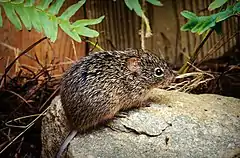| Sigmodontinae | |||
| J.A. Wagner, 1843[1] | |||
 Przedstawiciel podrodziny – bawełniak szczeciniasty (Sigmodon hispidus) | |||
| Systematyka | |||
| Domena | |||
|---|---|---|---|
| Królestwo | |||
| Typ | |||
| Podtyp | |||
| Gromada | |||
| Podgromada | |||
| Infragromada | |||
| Rząd | |||
| Podrząd | |||
| Infrarząd | |||
| Nadrodzina | |||
| Rodzina | |||
| Podrodzina |
bawełniaki | ||
| Typ nomenklatoryczny | |||
| Plemiona | |||
| |||
Bawełniaki[2] (Sigmodontinae) – bardzo rozległa, licząca kilkaset gatunków podrodzina gryzoni z rodziny chomikowatych (Cricetidae).
Zasięg występowania
Podrodzina obejmuje gatunki zasiedlające tereny Ameryki[3][4].
Systematyka
Układ filogenetyczny podrodziny Sigmodontinae jest dyskutowany przez naukowców. Podział na plemiona za Illustrated Checklist of the Mammals of the World i nowszymi publikacjami[3][5][6][7][2]:
- Sigmodontini J.A. Wagner, 1843
- Ichthyomyini Cockerell & Printz, 1914
- Plemię incertae sedis:
- Chinchillula O. Thomas, 1898 – szynszylaczek – jedynym przedstawicielem jest Chinchillula sahamae O. Thomas, 1898 – szynszylaczek górski
- Abrawayaomys Souza Cunha & Cruz, 1979 – duchaczek – jedynym przedstawicielem jest Abrawayaomys ruschii Souza Cunha & Cruz, 1979 – duchaczek leśny
- Delomys O. Thomas, 1917 – lasowiak
- Cordimus Zijlstra, McFarlane, Van Den Hoek Ostende & Lundberg, 2014 – takson wymarły po 1500 roku
- Reithrodontini Cazzaniga, Cañón & Pardiñas, 2019
- Oryzomyini Vorontsov, 1959
- Akodontini Cockerell & Printz, 1914
- Thomasomyini Steadman & Ray, 1982
- Andinomyini Salazar-Bravo, Pardiñas, Zeballo & Teta, 2016
- Euneomyini Pardiñas, Teta & Salazar-Bravo, 2015
- Wiedomyini Reig, 1980
- Abrothrichini D’Elía, Pardiñas, Teta & J.L. Patton, 2007
- Phyllotini Vorontsov, 1959
- Neomicroxini Pardiñas, Curay, Brito M., Cañón & Moratelli, 2021
- Rhagomyini Pardiñas, Tinoco, Barbière, Ronez, Cañón, Lessa, Koch & Brito M., 2022
Opisano również rodzaje wymarłe o niepewnej pozycji systematycznej i niesklasyfikowane w żadnym z powyższych plemion:
Przypisy
- ↑ J.A. Wagner: Supplementband. W: J.Ch. Schreiber: Die Säugthiere in Abbildungen nach der Natur, mit Beschreibungen. Cz. 3. Erlangen: Expedition des Schreber’schen säugthier- und des Esper’schen Schmetterlingswerkes, 1843, s. 398. (niem.).
- 1 2 Nazwy polskie za: W. Cichocki, A. Ważna, J. Cichocki, E. Rajska-Jurgiel, A. Jasiński & W. Bogdanowicz: Polskie nazewnictwo ssaków świata. Warszawa: Muzeum i Instytut Zoologii PAN, 2015, s. 244–257. ISBN 978-83-88147-15-9. (pol. • ang.).
- 1 2 C.J. Burgin, D.E. Wilson, R.A. Mittermeier, A.B. Rylands, T.E. Lacher & W. Sechrest: Illustrated Checklist of the Mammals of the World. Cz. 1: Monotremata to Rodentia. Barcelona: Lynx Edicions, 2020, s. 386–438. ISBN 978-84-16728-34-3. (ang.).
- ↑ D.E. Wilson & D.M. Reeder (red. red.): Subfamily Sigmodontinae. [w:] Mammal Species of the World. A Taxonomic and Geographic Reference (Wyd. 3) [on-line]. Johns Hopkins University Press, 2005. [dostęp 2020-11-28].
- ↑ U.F.J. Pardiñas, J. Curay, J. Brito M., C. Cañón & R. Moratelli. A unique cricetid experiment in the northern high-Andean Páramos deserves tribal recognition. „Journal of Mammalogy”. 102 (1), s. 164, 2021. DOI: 10.1093/jmammal/gyaa147. (ang.).
- ↑ U.F.J. Pardiñas, N. Tinoco, F. Barbière, C. Ronez, C. Cañón, G.M. Lessa, C. Koch & J. Brito M.. Morphological disparity in a hyperdiverse mammal clade: a new morphotype and tribe of Neotropical cricetids. „Zoological Journal of the Linnean Society”. 196 (3), s. 1013–1038, 2022. DOI: 10.1093/zoolinnean/zlac016. (ang.).
- ↑ N. Upham, C. Burgin, J. Widness, M. Becker, C. Parker, S. Liphardt, I. Rochon & D. Huckaby: Higher Taxonomy. [w:] ASM Mammal Diversity Database (Version 1.12) [on-line]. American Society of Mammalogists. [dostęp 2024-01-06]. (ang.).
- ↑ O.A. Reig. A new fossil genus of South American cricetid rodents allied to Wiedomys, with an assessment of the Sigmodontinae. „Journal of Zoology”. 192 (2), s. 266, 1980. DOI: 10.1111/j.1469-7998.1980.tb04233.x. (ang.).
- ↑ R.A. Martin, P. Peláez-Campomanes, C. Ronez, F. Barbière, T.S. Kelly, TE.H. Lindsay, J.A. Baskin, N.J. Czaplewski & U.F.J. Pardiñas. A new genus of cricetid rodent (Rodentia: Cricetidae) from the Clarendonian (Late Miocene) of North America and a consideration of sigmodontine origins. „Paludicola”. 12 (4), s. 303, 2020. (ang.).
- ↑ N.J. Czaplewski. Sigmodont rodents (Mammalia; Muroidea; Sigmodontinae) from the Pliocene (Early Blancan) Verde Formation, Arizona. „Journal of Vertebrate Paleontology”. 7 (2), s. 191, 1987. DOI: 10.1080/02724634.1987.10011652. (ang.).
Identyfikatory zewnętrzne:
This article is issued from Wikipedia. The text is licensed under Creative Commons - Attribution - Sharealike. Additional terms may apply for the media files.